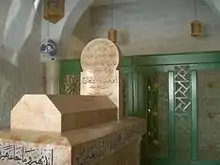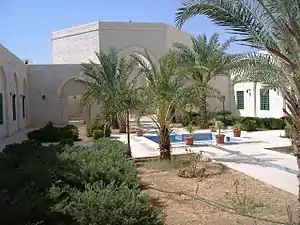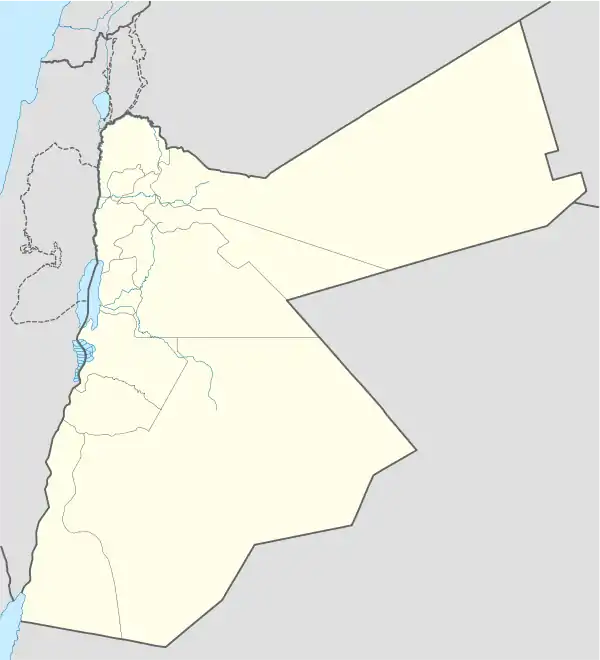Deir Alla
Deir Alla (Arabic: دير علا) is the site of an ancient Near Eastern town in Balqa Governorate, Jordan, thought to be the biblical Pethor,[2] while others thinking it to be the biblical Sukkot in Transjordan.[3]

Deir Alla
مدينة دير علا | |
|---|---|
City | |
 Shrine of Abu Ubaidah ibn al-Jarrah in Deir Alla | |
 Flag  Seal | |
 Deir Alla Location in Jordan | |
| Coordinates: 32°11′20″N 35°36′11″E | |
| Grid position | 208/178 |
| Country | Jordan |
| Province | Balqa Governorate |
| Municipality established | 1967 |
| Government | |
| • Mayor | Khalifa Solomen Diyat |
| Elevation | −1,030 ft (−314 m) |
| Population (2015)[1] | |
| • City | 7,321 |
| • Metro | 73,477 |
| Time zone | UTC+2 (GMT) |
| • Summer (DST) | +3 |
| Area code(s) | +(962)5 |
| Website | http://deirallacity.gov.jo/ |
The town was a sanctuary and metal-working centre, ringed by smelting furnaces built against the exterior of the city walls,[4] whose successive rebuildings, dated by ceramics from the Late Bronze Age, sixteenth century BCE, to the fifth century BCE, accumulated as a tell based on a low natural hill. The hopeful identification of the site as the biblical Sukkot is not confirmed by any inscription at the site. However, in Jerusalem Talmud Zeraim Shevi'it 9:2, Sukkot is referred as 'Darʿala or Tar'ellah' hence maybe deformed later into Deir Alla.[5]
Deir Alla was the first Bronze Age city excavated in Jordan. The initial expectations were of establishing a relative chronology of Palestine pottery in the transition between the Bronze Age to the Iron Age, established through meticulous stratigraphy. It was intended to span a gap between established chronologies at Jericho and Samaria.[6]
The oldest sanctuary at Deir Alla dates to the Late Bronze Age;[7] it was peacefully rebuilt at intervals, the floor being raised as the tell accumulated height, and the squared altar stone renewed, each new one placed atop the previous one. The final sanctuary was obliterated in a fierce fire; the blackened remains of an Egyptian jar bearing the cartouche of Queen Twosret gives a terminus post quem of c. 1200 BCE, a date consonant with other twelfth-century urban destruction in the Ancient Near East.[8] Unlike some other destroyed sites, Deir Alla's habitation continued after the disaster, without a break, into the Iron Age; the discontinuity was a cultural one, with highly developed pottery of a separate ceramic tradition post-dating the destruction.
On 20 August 2010, it recorded a scorching temperature of 51.1°C, the new official highest temperature in the history of Jordan.[9]
Archaeology
A series of Dutch excavations sponsored by the Netherlands Organisation for the Advancement of Pure Research began in 1960, under the auspices of the department of theology, University of Leiden. These excavations continued for five seasons until 1967. The excavation made its most dramatic discovery in 1967, an ink wall inscription relating a hitherto-unknown prophecy of Balaam, who thereby becomes the first Old Testament prophet to be identified in an inscription.[10]
At the end of the 1964 campaign, 11 clay tablets, 3 inscribed in a hitherto unknown possibly alphabetic script (Proto-Canaanite alphabet), 7 bearing only dots, and one uninscribed, were discovered.[2]
The Balaam inscription
The 1967 excavation revealed a many-chambered structure that had also been destroyed by earthquake, during the Persian period at the site. On a wall was written a story relating visions of the seer of the gods "Balʿam son of Beʿor" (Balaam son of Beor), who may be the same Balʿam son of Beʿor mentioned in Numbers 22–24 and in other passages of the Bible. The Deir Alla Balaam is associated with "a god bearing the name Shgr, 'Shadday' gods and goddesses, and with the goddess Ashtar."[11]
It reflects the oldest example of story from a biblical book (Numbers) written in a West Semitic alphabetic script, and is considered the oldest piece of West Semitic literature transmitted in a still debated Semitic language.[12] The Deir Alla Inscription is datable to ca. 840–760 BCE; it was written in red and black inks on a plastered wall; 119 pieces of inked plaster were recovered. The wall, near the summit of the tell, was felled by yet another tremor.[13]
History
Ottoman era
In 1596, during the Ottoman Empire, Deir Alla was noted in the census as being located in the nahiya of Gawr in the liwa of Ajloun. It had a population of 46 Muslim households and 4 Muslim bachelors. They paid a taxes on various agricultural products, including wheat, barley, sesame, cotton, goats and beehives, in addition to occasional revenues, water buffalos and a water mill; a total of 10,500 akçe.[14]
Ottoman era
The Jordanian census of 1961 found 1,190 inhabitants in Deir Alla.[15]
Tourist attractions
As well as being the site of the Deir Alla Inscription, Deir Alla is also the site of Battle of Fahl between the Muslim Caliphate and the Byzantine Empire. There are several tombs of Sahabah (followers of Muhammad) in Deir Alla:
Notes
- "The General Census - 2015" (PDF). Department of Population Statistics.
- W.H. Shea, "The Inscribed Tablets From Tell Deir `Alla" Archived 2015-04-12 at the Wayback Machine Archived 2015-04-12 at the Wayback Machine Andrews University Seminary Studies, vol. 27, pp. 21-37, 97-119, 1989.
- Franken, H.J. (1992). Deir Alla, tell (archaeology). Anchor Bible Dictionary, vol. 2.CS1 maint: location (link), citing a 4th-century text of the Jerusalem Talmud Zeraim (Shevi'it 9:2), where Sukkot is referred as Darʿala or Tar'ellah', thought to be a corruption of Deir Alla.
- Metal slag was found at every level, and often-rebuilt furnaces. (H.J. Franken, "The Excavations at Deir ʿAllā in Jordan" Vetus Testamentum 10.4 [October 1960, pp. 386-393], p 389).
- Franken, H.J. (1992). Deir Alla, tell (archaeology). Anchor Bible Dictionary, vol. 2.CS1 maint: location (link)
- Franken 1960:386-393.
- There had been earlier, but unrelated Chalcolithic inhabitants of the tell. Franken (1961:371)
- H.J. Franken, "The Excavations at Deir ֝Allā in Jordan: 2nd Season" Vetus Testamentum 11.4 (October 1961), pp. 361-372.
- "Archived copy". Archived from the original on 2011-08-23. Retrieved 2011-08-01.CS1 maint: archived copy as title (link)
- H. J. Franken and Ah J. Franken, Excavations at Tell Deir Alla: the Late Bronze Age Sanctuary, David Brown, 1992, ISBN 90-6831-408-4
- Thomas L. Thompson (2000). "Problems of Genre and Historicity with Palestine's Descriptions". In André Lemaire, Magne Saebo (ed.). Supplements to Vetus Testamentum, Volume 80. Brill. p. 322. ISBN 978-9004115989.
- J. Hoftijzer (ed.)The Balaam Text from Deir ‘Alla Re-evaluated (Leiden: Brill, 1991) ISBN 978-90-04-09317-1.
- J. Hoftijzer and G. van der Kooij, "Aramaic Texts from Deir 'Alla" Documenta et Monumenta Orientis Antiqui 19 (Leiden) 1976.
- Hütteroth and Abdulfattah, 1977, p. 168
- Government of Jordan, Department of Statistics, 1964, p. 17
Bibliography
- Government of Jordan, Department of Statistics (1964). First Census of Population and Housing. Volume I: Final Tables; General Characteristics of the Population (PDF).
- Hütteroth, Wolf-Dieter; Abdulfattah, Kamal (1977). Historical Geography of Palestine, Transjordan and Southern Syria in the Late 16th Century. Erlanger Geographische Arbeiten, Sonderband 5. Erlangen, Germany: Vorstand der Fränkischen Geographischen Gesellschaft. ISBN 3-920405-41-2.
- Een Verhalla voor het Oprapen. Opgravingen de Deir Alla in de Jordaanvallei, Leiden: Rijksmuseum van Oudheden, 1989. ISBN 90-71201-09-0